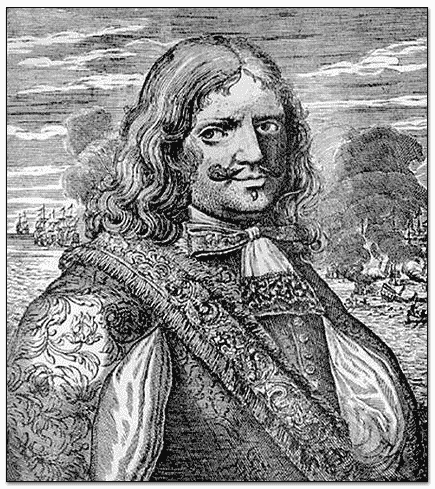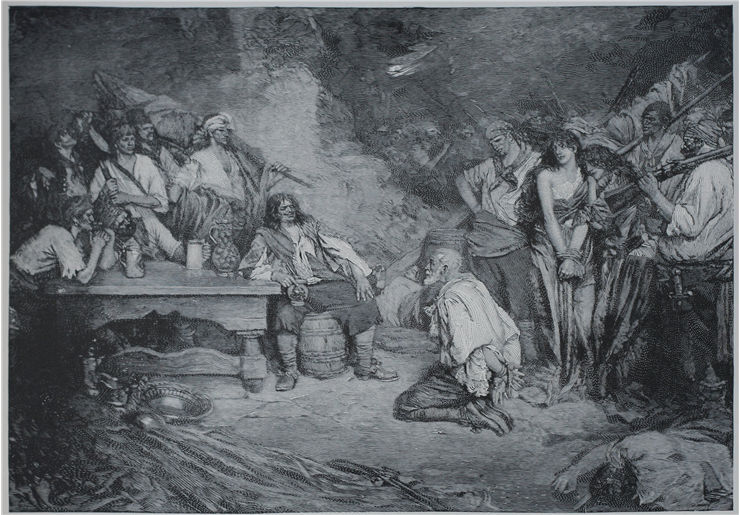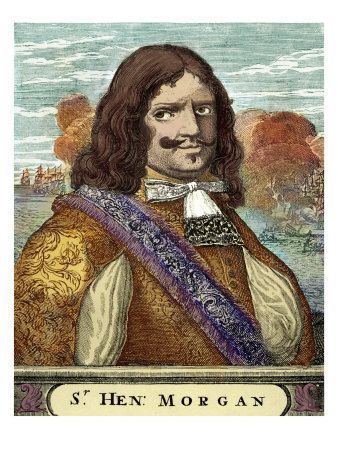Famous Pirate: Henry Morgan
The Buccaneer King
Despite some of his actions were brutal and illegitimate, Henry Morgan was not a pirate. The Welshman was a magnificent buccaneer , certainly the most famous one . Described as a remarkable leader and a fearsome conqueror, he had a couple of legendary battles and unique tactics which brought him fame and wealth. Because of all his deeds, Morgan was a true hero of the Caribbean and the English nation.
Henry Morgan was born around 1635 in Llanrhymny, Wells. Already as a youngster, Henry was ambitious and very lively person who could not settle with a monotonous life in a quiet place. He decided to move on because he had a dream to be a sailor. Although Morgan wanted to gain wealth and fame as soon as possible, a pirate way of life was not in his interest. Therefore, he joined the England’s naval army to serve as a buccaneer .
It is uncertain how Morgan arrived in Jamaica, but it happened in the in 1655, when island was occupied by the buccaneers. He joined the England forces which attacked and robbed Spanish colonies in the Caribbean . There he built his buccaneer career first as a common solider and soon as a respected sailor. By joining a famous captain, Christopher Myngs and his fleet on some of his expeditions, Morgan gained much more naval experience.
Finally, in 1662, he became a captain of a small privateering vessel. His first successful raid was in 1664, when a group of buccaneer captains harassed together. They plundered many ships and colonies on the coast of Yutacan Peninsula and the rich town Granada in Central America.
All those attacks brought him a great financial income and also an excellent reputation . He bought a plantation on Jamaica and married his cousin , Mary Elizabeth. She was the daughter of Morgan's uncle, Colonel Edward Morgan, the governor of Jamaica. Edward Morgan died soon after, in attack on the Dutch colony. The new governor of Jamaica was Sir Tomas Modyford , who became a very good friend to Henry Morgan . Because of that friendship and his constant success, Morgan was promoted to a vice-admiral of the Jamaican fleet.
Meanwhile, the Spanish activity increased in Cuba, so Mayford choose Morgan to lead the Jamaican fleet. In January 1668, more than 10 ships and over 500 soldiers sailed to Cuba. Once again Morgan turned nightmarish for Spain. The City of Puerto Principe was easily conquered without much loss. Problem was that this raid brought to his army only 50,000 pieces of eight. Many disappointed soldiers left Morgan.
Fearless Henry planned another attack right away despite his army was almost halved. Target was a fortified and a well-guarded town, Puerto Bello. The tactic that Morgan was using during this conflict was crucial . He anchored his ships far from the city and used the canoes to approach the city quietly at the night. The attack was quick, the guards were unaware and two of the three main forts were easily conquered. However, the third one was almost impossible to occupy. Then Morgan came up with a brilliant idea to use the imprisoned monks and nuns as a human shield. With that strategy they succeed to conquer the last obstacle. The Buccaneers captured the town and the governor of Panama was forced to pay a lot for the slaves. 250,000 pieces of eight were taken from that impressive raid.
Next Morgan's terror took place in Venezuela in 1669. With 8 ships and 650 crewmen he conquered the city of Marcaibo. His buccaneers tortured many Venezuelan citizens almost like the cruelest pirates, in order to discover all hidden booty .
At that time, Morgan was the indisputable king of all buccaneers . He had wealth, the most powerful army in the Caribbean , and what is most important, a constant success. In most fights, Morgan performed such achievements that even Spaniards praised his bravery and leadership.
With the powerful force of 1200 buccaneers and 30 ships, his last great attack began in 1670. It was the greatest challenge and his main goal - Panama. First he took fort, San Lorenzo, which allowed his troops to reach Panama through the jungle. However, it turnout that trip was much more exhausting than Morgan expected. He lost many people because of hunger and sickness. However, buccaneers' charismatic captain boosted everyone's moral and they finally reached their goal. An enormous number of Spaniards was gathered in order to defend the rich city, but they could to nothing against the supreme army of buccaneers. The city was taken in the great fight and then entirely plundered and demolished. That happened to be the last Morgan's raid .
Actually, he did not know that he had committed act of piracy . England and Spain had been at peace when last attack occurred, so after his return to Jamaica, Morgan was promptly arrested by the new governor and shipped to England for a trial. However, that trail never happened. Morgan was a powerful and influential man with many great deeds for England behind him. Although a prisoner of state, he has never been punished. Instead, he was honored by the King and promoted to the deputy governor of Jamaica. In the period between 1674 and 1682, he was still military active in defense of the island from the pirates.
Retirement & Legacy of Henry Morgan
The severity of the Morgan's destruction of Panama in 1671 reached such a level that entire city had to be re-established several kilometers from its original ruins, raising the tensions between Spain and England whose governments have signed a peace treaty year earlier in 1670. With treaty hanging on balance, English decided to promptly remove Henry Morgan from his military post. Morgan was arrested and ordered to return to England where he was stripped of his position in the Navy. However because his significant influence, Morgan was not punished for many of his horrific acts. He was knighted in 1674 and was awarded the position of the Lieutenant Governor position in Jamaica in 1675. Six years later in 1681, the relations between Henry Morgan and King Charles II were soured, which caused his removal from the governor position. New appointment to the place of Governor could not be worse for Morgan, for it was awarded to his longtime political rival Thomas Lynch.
Immediately after arriving on the post of Governor, Thomas Lynch launched several political attacks against Morgan, most successfully by promoting the 1678 book “De Americaensche Zee-Roovers“ (About the Buccaneers of America, today known as one of the most important reports concerning the 17th century Age of Piracy) written by the Alexandre Excqemelin who described him in the report as savage, bloodthirsty, and responsible for many horrific attacks against natives, naval shipping and citizens of the city of Panama. Morgan immediately counter-attacked, launching not only public campaign to discredit the book but also a libel suit in which he was awarded not only two hundred English pounds from the publishers of the book William Crooke and Thomas Malthus, but also a public retraction.
Morgan spent rest of his life peacefully with his wife, on a big plantation. When he died in 1688, almost no buccaneers in the Caribbean were active.
After the death of Governor Thomas Lynch, Morgan was reinstated to the Council in 1688. That same year he died on August 25, many believing from Tuberculosis or dropsie. He left his estate to his two godsons and secured regular payments to his sister. Henry Morgan was buried in Palisadoes cemetery in Jamaica which was sunk into the sea during the 1692 earthquake that drove the majority of the Port Royal City, the wealthiest and largest city in West Indies, below the waves.
In modern times Henry Morgan is remembered both as a historical figure that played prominent role in the Golden Age of the Piracy, as one of the most successful naval commanders who managed to take advantage of strained relationship between governments involved in the New World to launch his own buccaneering attack all across the Caribbean and gain significant wealth for himself, his crew and the English crown. The romanticized version of him is present in many films and books, including a mention in a popular Hollywood film franchise “Pirates of the Caribbean”.
In the summer of 2011 was reported that the archaeologists from Texas State University managed to locate remains of the Morgan's sunk flagship “Satisfaction”. Subsequent dives to the ocean flow managed to identify the wreck as a Spanish merchant ship “Encarnación” who sunk off the coast of Panama during the powerful storm in 1681.


